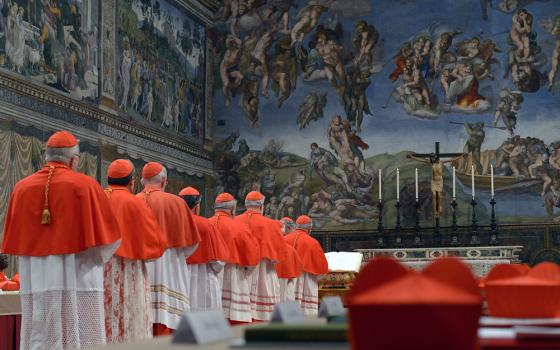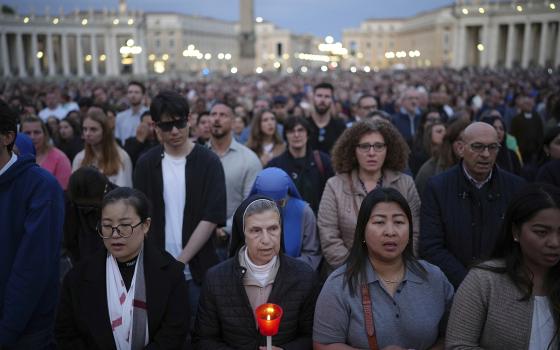Twice this year, I have had the pleasure of reading a book that is so compelling, so smart, and so important to the issues of the day, that I want to urge readers to rush out and buy it right this second. The first was Brad Gregory’s “The Unintended Reformation,” and now I add Lew Daly’s “God’s Economy: Faith-Based Initiatives & the Caring State.” This book was published in 2009 and, for some reason, was only brought to my attention this summer. I am embarrassed that I had not read it before. But, it remains as pertinent, perhaps more so, than three years ago as it treats the issue that has stalked the 2012 election campaign, the relationship of government to society and the individuals within society, and for Catholics there is the added benefit that Daly’s examination of faith-based initiatives illuminates the debate over the HHS mandate in important ways.
The White House Office of Faith-Based Initiatives was one of the most innovative policy proposals to come from the presidency of George W. Bush. It was part, indeed the central part, of Bush’s call for a “compassionate conservatism.” Although Bush’s presidency would come to be defined by the fight against terrorism, which will reverberate through U.S. foreign policy for decades, his creation of the faith-based office may provoke an even greater long-term effect on U.S. domestic policy.
The roots of the idea were two-fold. On the one hand, the legal environment was changing by 2000. After decades of Supreme Court decisions that focused on the establishment clause, each time building the “wall of separation” between Church & State a little higher, in the 1990s, the Court began to recognize that an overly strict interpretation of the establishment clause could overwhelm the free exercise clause, and that religious believers and institutions might be penalized because of their religion, denied access to government funding that non-religious actors routinely enjoyed, or forced to self-secularize themselves in order to get government funding.
The deeper, and more interesting, antecedent for the faith-based office is found in the writings of certain nineteenth century Christian thinkers, most especially the Calvinistic theologian and politician Abraham Kuyper and Pope Leo XIII. Both men were opposed to the emerging, omnipotent liberal state – think the Kulturkampf in Germany and the anti-Catholic legislation of the French Third Republic – and to the emerging omnipotent liberal market. Both Kuyper and Leo understood society in organic terms, not in the contractural, rights-based terms of modern liberalism. Both were deeply concerned about the powerlessness of isolated and therefore weakened individuals before the power of the state or the market if intermediate social organizations did not exist to protect them, from guilds to unions to churches and, most especially, the family. And, most especially, both men recognized that the measure of good government and economic justice must be the ability of families to care for themselves, of communities to flourish, not just individuals, and of the culture to maintain some sense of inter-personal connectedness.
Daly also notes that in the formation of the faith-based office, some of Bush’s fervent supporters jumped ship, even Marvin Olasky who is credited with assembling the “compassionate conservative” agenda. Olasky and others wanted the faith-based office to be a vehicle not only for empowering faith-based social service agencies, but to have those religious agencies eventually replace government assistance. Bush was not trying to cut government spending, however, and was focused on empowering religious agencies in such a way that they did not have to secularize themselves to obtain government contracts. He wanted the government to respect their autonomy and integrity, but Bush did not intend to dry up the funding sources from the government. Olasky bailed. The episode was akin to Congressman Paul Ryan’s confusing federalism with subsidiarity.
If Bush gets credit for standing up to fellow Republicans who wanted to slash government spending on social services, he gets demerits for only grasping half of the Kuyper-Leonine indictment, which concerned the market as well as the state. “One looked in vain for even the faintest echo of such a fundamental critique of liberalism in Bush’s faith-based plan, even as the political liberalism of the welfare state was challenged as never before, in a pluralistic rethinking of church-state law,” Daly writes. “The great defenders of religious autonomy more than a century ago did not stop at confronting governments. By contrast, Bush’s defense of religious providers seemed merely to superimpose a social critique of liberal statism on top of an unquestioning liberal allegiance to markets….Surely the question must be, What is the ‘ultimate good’ of church autonomy in social services if poverty continues to grow and society grows more unequal with each passing day?”
The important critique of liberalism in the nineteenth century – not the Royalist, restorationist critique – was not merely theoretical. It was rooted in the experience of poverty, modern, industrial, urban poverty. Men like Bishop Wilhelm von Ketteler of Mainz and Guillaume Groen van Prinsterer. Groen had a profound influence on Kuyper as one can see from this quote:
Our worst ailment is pauperism….It came from ‘Liberty and Equality’ as understood by the Revolution. Just one detail. When that slogan was raised, guilds and corporations too had to go. The desire was for free competition; no restraints on skills and industry; no hateful monopoly exercised by individuals or societies; then the development of private initiative and commerce would guarantee a better future. The future that was envisioned has arrived. Can it be called better? I am of one voice here with the leading spokesmen of the present-day revolution. It is this liberty, this unrestricted competition, this removal, as much as possible, of the natural relationship of employer and employee, which tears the social bonds, ends in the dominance of the rich and the rule of the banking house, robs artisans of regular sustenance, splits society into two hostile camps, gives rise to a countless host of paupers, prepares for the attack of the have-nots on the well-to-do and would in many people’s eyes render such a deed excusable and almost lawful. It has brought Europe to a state so dreary and somber as to cause many to tremble and cry out. Is there no way to revive, in some altered form, the associations that were so recklessly crushed under the revolutionary ruins?
Here was the cry for civil society to return to a more naturalistic self-understanding, a more moral compass, and greater autonomy from both the state and the emerging titans of industry. In Europe, this impulse gave rise to the emergence of Christian Democratic parties. Daly notes that in the U.S. social spending has run about 40 percent lower than in countries which built their social welfare systems out of the Christian Democratic tradition, and that poverty in the U.S. is about twice as high as found in those countries as well.
Eventually, America, like Europe, turned to the state as the only effective means of countering the acquired, suffocating, impoverishing power of the market. In part, developments in America’s legal framework gave corporations a legal invulnerability that was denied to unions, families, and communities. As Daly notes, when a man is fired, he may sue his company as an employee, but not as a father and husband. It took the Great Depression to finally force America to confront the need for a different understanding of social relations.
A key player in this development was Msgr. John A. Ryan, who led the Catholic Bishops’ Conference Social Action Department and who became a friend of Franklin Roosevelt’s. Ryan rooted his understanding of property in the writings of St. Thomas Aquinas. Daly writes,
For Thomas, private property is notably an integral feature of the common good and useful for human society, but it is a conventional institution fully subordinate to the directives of God’s law, which is oriented to the common welfare. Thus, property is defined as having a twofold nature of private possession and common use. “Man may fully possess [material goods] as his own,” Thomas wrote. But “as regards their use….a man ought not to look upon them as his own, but as common, so that he may readily minister to the needs of others.”
In today’s debased political discourse, Fox News would doubtlessly label St. Thomas Aquinas a socialist for holding such views.
The Catholic vision of the common good became part of the rhetorical and ideological structure of the New Deal. In 1936, the Democratic Party platform set as its primary objective “The Protection of the Family and the Home.” In 1937, the Supreme Court decision in West Coast Hotel v. Parrish, written by Chief Justice Charles Evans Hughes, was so filled with Catholic sensibilities, it might have been written by Msgr. Ryan – it wasn’t. “The community is not bound to provide what is in effect a subsidy for unconscionable employers,” Hughes wrote. “The community may direct its law-making power to correct the abuse which springs from their selfish disregard of the public interest.” The case involved the minimum wage.
Catholics must recommit themselves to the common good in our nation’s political life. A recent Pew study showed that self-identified “moderate Catholics” tend to side with liberal Catholics on same-sex marriage, but side with conservative Catholics in believing big government is a problem. Let us stipulate: Big government can be a problem. But, this was the genius of the faith-based initiative. Aid to the poor need not entail “big government.” And, as a bonus, faith-based social services can help to reconstitute the fabric of civil society in ways that will place a check on both the omnipotent state and the omnipotent market.
President Obama decided to continue and even improve the faith-based office. Funding for Catholic Charities has grown significantly in the last four years. Which is another reason the
There is no evidence that religious organizations out-perform non-religious organizations in providing social services, although there is also no evidence that they don’t. That is not what is exciting, potentially, about the faith-based initiative. Daly perceives a ray of hope we desperately need. “Yet in this new era of faith-based initiatives, we find a type of communal freedom flourishing in the design of American social policy. And by this example, a new light dawns on American liberalism’s exclusion of family and community from legal subjectivity and the domain of rights. It shows the way to a better future.” There is a still deeper hope. The more the Christian churches are involved in civil society, the more likely that society will be attuned to the teachings of the Gospel. Some versions of the Bible put the words of Jesus in red ink, and the red words are all about caring for the poor. In America today, so heartless, so willing to overlook those whose rights are inconvenient, from the unborn to the undocumented, we need more attention to the red words.
Daly’s book is a must-read. As I said at the beginning, I am ashamed I had not read it previously. Here is a policy that holds out the hope that our nation’s political class might begin to transcend, rather than endlessly re-litigate, the culture wars and build a more humane culture in the meantime. Daly issues a call, not to arms, but to alms, with a vibrant role for government to be sure, but an even more vibrant role for those institutions that have too long suffered from an economy geared towards rewards on investment instead of rewards for us all. Here is the future of the common good. And, Lew Daly joins the ranks of my favorite public intellectuals.



